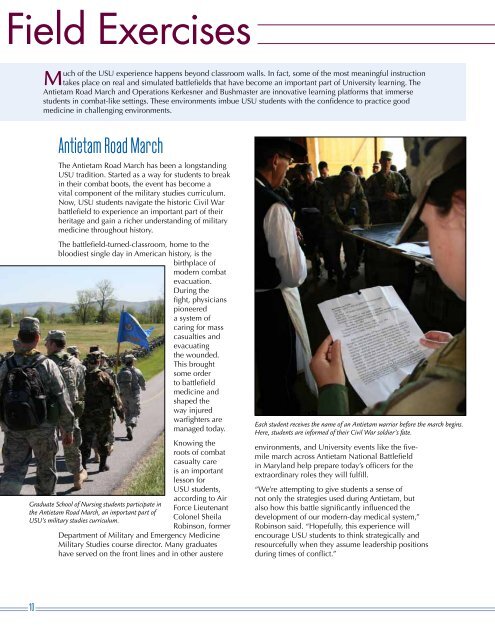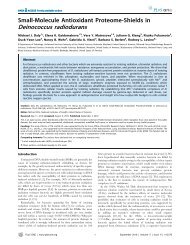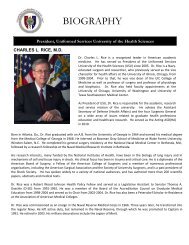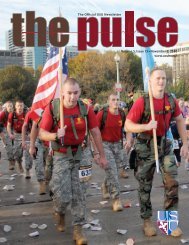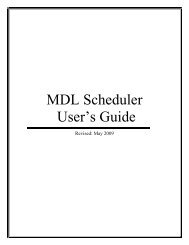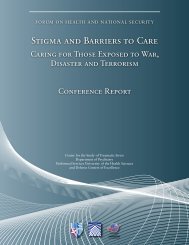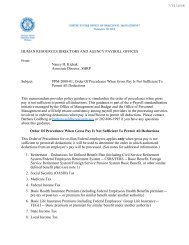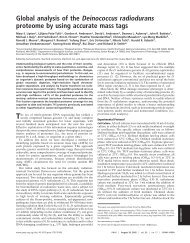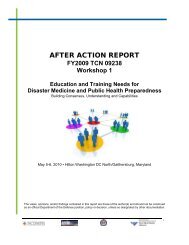2010 Report - Uniformed Services University of the Health Sciences
2010 Report - Uniformed Services University of the Health Sciences
2010 Report - Uniformed Services University of the Health Sciences
You also want an ePaper? Increase the reach of your titles
YUMPU automatically turns print PDFs into web optimized ePapers that Google loves.
Field Exercises<br />
Much <strong>of</strong> <strong>the</strong> USU experience happens beyond classroom walls. In fact, some <strong>of</strong> <strong>the</strong> most meaningful instruction<br />
takes place on real and simulated battlefields that have become an important part <strong>of</strong> <strong>University</strong> learning. The<br />
Antietam Road March and Operations Kerkesner and Bushmaster are innovative learning platforms that immerse<br />
students in combat-like settings. These environments imbue USU students with <strong>the</strong> confidence to practice good<br />
medicine in challenging environments.<br />
Antietam Road March<br />
The Antietam Road March has been a longstanding<br />
USU tradition. Started as a way for students to break<br />
in <strong>the</strong>ir combat boots, <strong>the</strong> event has become a<br />
vital component <strong>of</strong> <strong>the</strong> military studies curriculum.<br />
Now, USU students navigate <strong>the</strong> historic Civil War<br />
battlefield to experience an important part <strong>of</strong> <strong>the</strong>ir<br />
heritage and gain a richer understanding <strong>of</strong> military<br />
medicine throughout history.<br />
The battlefield-turned-classroom, home to <strong>the</strong><br />
bloodiest single day in American history, is <strong>the</strong><br />
birthplace <strong>of</strong><br />
modern combat<br />
evacuation.<br />
During <strong>the</strong><br />
fight, physicians<br />
pioneered<br />
a system <strong>of</strong><br />
caring for mass<br />
casualties and<br />
evacuating<br />
<strong>the</strong> wounded.<br />
This brought<br />
some order<br />
to battlefield<br />
medicine and<br />
shaped <strong>the</strong><br />
way injured<br />
warfighters are<br />
managed today.<br />
Knowing <strong>the</strong><br />
roots <strong>of</strong> combat<br />
casualty care<br />
is an important<br />
lesson for<br />
USU students,<br />
according to Air<br />
Graduate School <strong>of</strong> Nursing students participate in<br />
Force Lieutenant<br />
<strong>the</strong> Antietam Road March, an important part <strong>of</strong><br />
USU’s military studies curriculum.<br />
Colonel Sheila<br />
Robinson, former<br />
Department <strong>of</strong> Military and Emergency Medicine<br />
Military Studies course director. Many graduates<br />
have served on <strong>the</strong> front lines and in o<strong>the</strong>r austere<br />
Each student receives <strong>the</strong> name <strong>of</strong> an Antietam warrior before <strong>the</strong> march begins.<br />
Here, students are informed <strong>of</strong> <strong>the</strong>ir Civil War soldier’s fate.<br />
environments, and <strong>University</strong> events like <strong>the</strong> fivemile<br />
march across Antietam National Battlefield<br />
in Maryland help prepare today’s <strong>of</strong>ficers for <strong>the</strong><br />
extraordinary roles <strong>the</strong>y will fulfill.<br />
“We’re attempting to give students a sense <strong>of</strong><br />
not only <strong>the</strong> strategies used during Antietam, but<br />
also how this battle significantly influenced <strong>the</strong><br />
development <strong>of</strong> our modern-day medical system,”<br />
Robinson said. “Hopefully, this experience will<br />
encourage USU students to think strategically and<br />
resourcefully when <strong>the</strong>y assume leadership positions<br />
during times <strong>of</strong> conflict.”<br />
10


